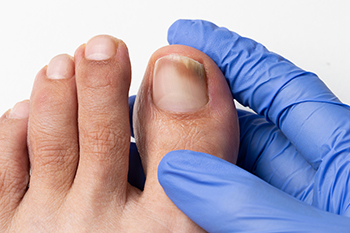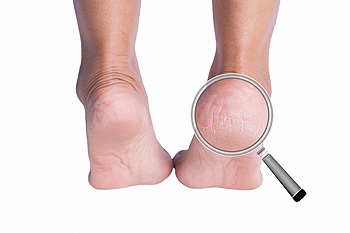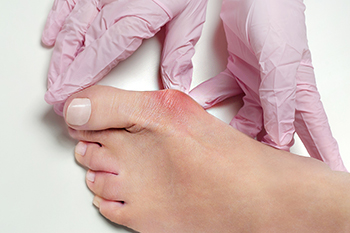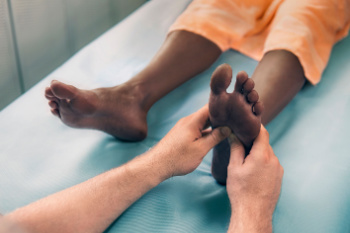Items filtered by date: June 2025
Causes of Toenail Fungus

Toenail fungus, medically known as onychomycosis, is an infection caused by fungi that feeds on keratin which is the protein that makes up the hard surface of the toenails. This often leads to thickened, discolored, brittle, or distorted nails. Risk factors include poor foot hygiene, excessive moisture, wearing tight shoes, or having conditions like diabetes or weakened immunity. Diagnosis is made through a clinical exam and sometimes a lab test to confirm the fungal source. If you have symptoms of toenail fungus, it is suggested that you consult a podiatrist who can offer you effective treatment solutions, which may include prescribed medication.
For more information about treatment, contact Judson Siegel, DPM of Assabet Family Podiatry. Our doctor can provide the care you need to keep you pain-free and on your feet.
Toenail Fungus Treatment
Toenail fungus is a condition that affects many people and can be especially hard to get rid of. Fortunately, there are several methods to go about treating and avoiding it.
Antifungals & Deterrence
Oral antifungal medicine has been shown to be effective in many cases. It is important to consult with a podiatrist to determine the proper regiment for you, or potentially explore other options.
Applying foot powder on the feet and shoes helps keep the feet free of moisture and sweat.
Sandals or open toed shoes – Wearing these will allow air movement and help keep feet dry. They also expose your feet to light, which fungus cannot tolerate. Socks with moisture wicking material also help as well.
If you have any questions please contact our offices located in Plainville, Marlborough, and Somerset, MA . We offer the newest diagnostic and treatment technologies for all your foot and ankle needs.
Keep Your Feet Healthy So You Can Stay Active
Keeping Heels Smooth and Preventing Cracks

Dry, cracked heels are often the result of pressure, friction, or lack of moisture. To maintain soft, healthy skin, it is important to care for your feet regularly. Using a gentle foot file on clean, dry skin helps remove buildup without causing irritation. Applying a thick, fragrance-free moisturizer daily can restore hydration and improve skin texture. Wearing supportive, closed-back shoes protects the heels from excess rubbing and helps retain moisture. Avoid walking barefoot on hard surfaces, which can dry and harden the skin over time. For deeper cracks or skin that splits and becomes painful, further care may be necessary. If your dry or cracked heels persist or worsen, it is suggested that you see a podiatrist for treatment to restore comfort and prevent infection or other complications.
If the skin on your feet starts to crack, you may want to see a podiatrist to find treatment. If you have any concerns, contact Judson Siegel, DPM from Assabet Family Podiatry. Our doctor can provide the care you need to keep you pain-free and on your feet.
Cracked Heels
It is important to moisturize your cracked heels in order to prevent pain, bleeding, and infection. The reason cracked heels form is because the skin on the foot is too dry to support the immense pressure placed on them. When the foot expands, the dry skin on the foot begins to split.
Ways to Help Heal Them
- Invest in a good foot cream
- Try Using Petroleum Jelly
- Ease up on Soaps
- Drink Plenty of Water
Ways to Prevent Cracked Heels
- Moisturize After Showering
- Skip a Shower
- Keep Shower Water Lukewarm
- Don’t Scrub Your Feet
If you are unsure how to proceed in treating cracked heels, seek guidance from a podiatrist. Your doctor will help you with any questions or information you may need.
If you have any questions, please feel free to contact our offices located in Plainville, Marlborough, and Somerset, MA . We offer the newest diagnostic and treatment technologies for all your foot care needs.
Treatment and Complications of Bunions

A bunion is a bony growth that develops at the base of the big toe when the joint becomes misaligned. Bunions are often the result of inherited foot structure problems, such as flat feet or joint looseness. Over time, the top of the toe leans inward, causing pain, swelling, and difficulty walking. Bunions can lead to complications, if ignored. Bursitis, which is inflammation of the joint's fluid-filled sac, may develop and cause additional pain and stiffness. Other complications include hammertoes, overlapping toes, metatarsal pain, and thickened skin or calluses. In certain cases, joint damage can limit motion in the big toe or result in permanent deformity. A podiatrist can assess the severity of the bunion and determine the most appropriate care. Treatment options include custom orthotics to relieve pressure or bunion surgery to realign the bones and remove inflamed tissue. If you have painful bunions, it is suggested that you schedule an appointment with a podiatrist for an exam and appropriate treatment options.
If you are suffering from bunion pain, contact Judson Siegel, DPM of Assabet Family Podiatry. Our doctor can provide the care you need to keep you pain-free and on your feet.
What Is a Bunion?
Bunions are painful bony bumps that usually develop on the inside of the foot at the joint of the big toe. As the deformity increases over time, it may become painful to walk and wear shoes. Women are more likely to exacerbate existing bunions since they often wear tight, narrow shoes that shift their toes together. Bunion pain can be relieved by wearing wider shoes with enough room for the toes.
Causes
- Genetics – some people inherit feet that are more prone to bunion development
- Inflammatory Conditions - rheumatoid arthritis and polio may cause bunion development
Symptoms
- Redness and inflammation
- Pain and tenderness
- Callus or corns on the bump
- Restricted motion in the big toe
In order to diagnose your bunion, your podiatrist may ask about your medical history, symptoms, and general health. Your doctor might also order an x-ray to take a closer look at your feet. Nonsurgical treatment options include orthotics, padding, icing, changes in footwear, and medication. If nonsurgical treatments don’t alleviate your bunion pain, surgery may be necessary.
If you have any questions, please feel free to contact our offices located in Plainville, Marlborough, and Somerset, MA . We offer the newest diagnostic and treatment technologies for all your foot care needs.
Shoes and Orthotics Can Help Relieve Rheumatoid Arthritis Pain

Rheumatoid arthritis can make each step feel like a challenge. The joints in the feet often become inflamed and tender, which can lead to pain, stiffness, and difficulty walking. Finding the right footwear becomes more than a comfort issue, It becomes part of managing daily life. Orthotics can help ease pressure on affected areas, improve alignment, and support the foot’s structure. Special shoes designed for people with arthritis often have a wider toe box, soft interiors, and extra depth to accommodate inserts. These small changes can have a big impact on how the feet feel during the day. Walking should not be a painful task. If you live with rheumatoid arthritis and have noticed changes in how your feet feel or move, it is suggested that you see a podiatrist for proper relief options.
Because RA affects more than just your joints, including the joints in your feet and ankles, it is important to seek early diagnosis from your podiatrist if you feel like the pain in your feet might be caused by RA. For more information, contact Judson Siegel, DPM of Assabet Family Podiatry. Our doctor will assist you with all of your podiatric concerns.
What Is Rheumatoid Arthritis?
Rheumatoid Arthritis (RA) is an autoimmune disorder in which the body’s own immune system attacks the membranes surrounding the joints. Inflammation of the lining and eventually the destruction of the joint’s cartilage and bone occur, causing severe pain and immobility.
Rheumatoid Arthritis of the Feet
Although RA usually attacks multiple bones and joints throughout the entire body, almost 90 percent of cases result in pain in the foot or ankle area.
Symptoms
- Swelling and pain in the feet
- Stiffness in the feet
- Pain on the ball or sole of feet
- Joint shift and deformation
Diagnosis
Quick diagnosis of RA in the feet is important so that the podiatrist can treat the area effectively. Your doctor will ask you about your medical history, occupation, and lifestyle to determine the origin of the condition. Rheumatoid Factor tests help to determine if someone is affected by the disease.
If you have any questions, please feel free to contact our offices located in Plainville, Marlborough, and Somerset, MA . We offer the newest diagnostic and treatment technologies for all your foot care needs.

